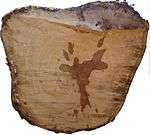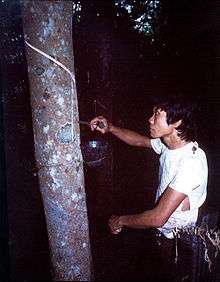Hevea brasiliensis
| Rubber tree | |
|---|---|
 | |
| Scientific classification | |
| Kingdom: | Plantae |
| (unranked): | Angiosperms |
| (unranked): | Eudicots |
| (unranked): | Rosids |
| Order: | Malpighiales |
| Family: | Euphorbiaceae |
| Subfamily: | Crotonoideae |
| Tribe: | Micrandreae |
| Subtribe: | Heveinae |
| Genus: | Hevea |
| Species: | H. brasiliensis |
| Binomial name | |
| Hevea brasiliensis Müll.Arg. | |
Hevea brasiliensis, the Pará rubber tree, sharinga tree, or, most commonly, the rubber tree, is a tree belonging to the family Euphorbiaceae. It is the most economically important member of the genus Hevea. It is of major economic importance because the milky latex extracted from the tree is the primary source of natural rubber.
Rubber tree plantation

In the wild, the tree can reach a height of up to 100 feet (30 m). The white or yellow latex occurs in latex vessels in the bark, mostly outside the phloem. These vessels spiral up the tree in a right-handed helix which forms an angle of about 30 degrees with the horizontal, and can grow as high as 45 ft.
In plantations, the trees are generally smaller for two reasons: 1) Trees grow more slowly when they are tapped for latex, and 2) trees are generally cut after 30 years because latex production declines as trees age, and they are no longer economically viable.
The tree requires a tropical or subtropical climate with a minimum of about 1200 mm/yr of rainfall, and without frost.[1] If frost does occur, the results can be disastrous for production. One frost can cause the rubber from an entire plantation to become brittle and break once it has been refined.
Latex tapping


Harvesters make incisions across the latex vessels, just deep enough to tap the vessels without harming the tree's growth, and the latex is collected in small buckets. This process is known as rubber tapping. Latex production is highly variable from tree to tree and across clone types.
Wood harvesting
As latex production declines with age, rubber trees are generally felled when they reach the age of 25 to 30 years. The earlier practice was to burn the trees, but in recent decades, the wood has been harvested for furniture making.
History
The Pará rubber tree initially grew only in the Amazon Rainforest. Increasing demand and the discovery of the vulcanization procedure in 1839 led to the rubber boom in that region, enriching the cities of Belém and Manaus. The name of the tree derives from Pará, the second-largest Brazilian state, the capital of which is Belém.
These trees were used to obtain rubber by the natives who inhabited its geographical distribution. The Olmec people of Mesoamerica extracted and produced similar forms of primitive rubber from analogous latex-producing trees such as Castilla elastica as early as 3600 years ago. The rubber was used, among other things, to make the balls used in the Mesoamerican ballgame. Early attempts were made in 1873 to grow H. brasilensis outside Brazil. After some effort, 12 seedlings were germinated at the Royal Botanic Gardens, Kew. These were sent to India for cultivation, but died. A second attempt was then made, some 70,000 seeds being smuggled to Kew in 1875, by Henry Wickham, at the service of the British Empire.[2][3][4][5] About 4% of these germinated, and in 1876, about 2000 seedlings were sent, in Wardian cases, to Ceylon (modern day Sri Lanka) and 22 were sent to the Botanic Gardens in Singapore. Once established outside its native country, rubber was extensively propagated in the British colonies. Rubber trees were brought to the botanical gardens at Buitenzorg, Java, in 1883.[6] By 1898, a rubber plantation had been established in Malaya, and today, most rubber tree plantations are in South and Southeast Asia, with some also in tropical West Africa.
Efforts to cultivate the tree in South America (Amazon) were unsatisfactory because of blight.[1] The blight, called South American leaf blight, is caused by the Ascomycota, Microcyclus ulei[7] or Pseudocercospora ulei.[8]
Environmental concerns
The toxicity of arsenic to insects, bacteria, and fungi has led to the heavy use of arsenic trioxide on rubber plantations, especially in Malaysia.[9]
The majority of the rubber trees in Southeast Asia are clones of varieties highly susceptible to the South American leaf blight--Microcyclus ulei. For these reasons, environmental historian Charles C. Mann, in his 2011 book, 1493: Uncovering the New World Columbus Created, predicts that the Southeast Asian rubber plantations will be ravaged by the blight in the not-too-distant future, thus creating a potential calamity for international industry (p275-278).
Synonyms
The genus Hevea is also known as:
- Caoutchoua J.F.Gmel.
- Micrandra Benn. & R.Br.
- Siphonanthus Schreb. ex Baill.
- Siphonia D.Richard ex Schreb.
- Siphopnicna F.Jansen ex Schreb.
Gallery
-
Leaves of a Pará rubber tree
-

Mindanao, Philippines, plantation worker
-

Rubber tree in Malaysia
-
Fruits and seeds of a rubber tree
See also
- Castilla elastica - the principal source of latex rubber among the pre-Columbian MesoAmerican peoples
- List of plants of Amazon Rainforest vegetation of Brazil
- Rubberwood
- Rubber seed oil
- Red Rubber Scandal - was one of the first humanitarian global campaigns but concerned the rubber vine species
Notes
- 1 2 "Elastomer-The rubber tree", Encyclopaedia Britannica, 2008
- ↑ "The Brazilian Armed Forces: Current changes, new challenges", Dreifuss, R. Armand. International Seminar Research Committee Armed Forces and Society, Romania, 2002. Retrieved August 19, 2009 from http://www.nestbrasil.com/rest/page8/files/rested1-dreyfus.pdf (p. 55)
- ↑ "Amazon - The Animation", Greepeace Digital. Artificial Environments, n/d. Retrieved August 19, 2009 from http://www.ae-pro.com/preview.php?preid=31&pro=Amazon
- ↑ "Seringueira", Wikipédia, a enciclopédia livre, 2009. Retrieved 11h05min, August 19, 2009 from http://pt.wikipedia.org/w/index.php?title=Seringueira&oldid=15936263
- ↑ "Acre: História e etnologia", Marco António Gonçalves (Org.). Núcleo de Etnologia Indígena Laboratório de Pesquisa Social/IFCS - UFRJ, n/d. Retrieved August 19, 2009 from http://eduardoeginacarli.blogspot.com/2007_07_01_archive.html
- ↑ Winchester, Simon (2003). Krakatoa: The Day the World Exploded, August 27, 1883. HarperCollins. pp. 223–224. ISBN 0-06-621285-5.
- ↑ South American Leaf Blight of rubber (Microcyclus ulei), plantwise.org
- ↑ Erasing the Past: A New Identity for the Damoclean Pathogen Causing South American Leaf Blight of Rubber
- ↑ Sabina C. Grund, Kunibert Hanusch, Hans Uwe Wolf (2005), "Arsenic and Arsenic Compounds", Ullmann's Encyclopedia of Industrial Chemistry, Weinheim: Wiley-VCH, doi:10.1002/14356007.a03_113.pub2
References
- Brazilian Association of Rubber Goods - ABIARB
- National Association Tire Industry - ANIP (Brazil)
- Sao Paulo's Association of Rubber Producers and Processors - APABOR (Brazil)
- Bio ecological production of rubber without fertilizing in Malaysia - BioRubber
- Brazilian Natural Rubber
- LATEKS magazine (Brazil)
- Seringueira.com - Brazilian rubber tree consulting
Further references
- Zhang, J., Huss, V.A.R., Sun, X., Chang, K. and Pan, D. 2008. Morphology and phylogenetic position of a trebouxiophycean green algae (Chlorophyta) growing on the rubber tree, Hevea brasiliensis, with the description of a new genus and species. Eur. J. Phycol. 43(2): 185 - 193.
External links
| Wikimedia Commons has media related to Hevea brasiliensis. |